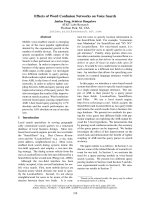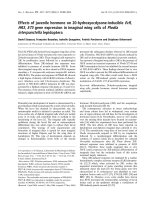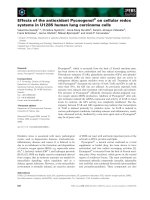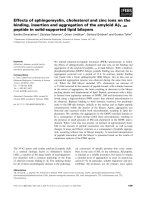Báo cáo khoa học: "Effects of Multiple-purpose Microorganic Compost B2006-32-21 on Paddy Rice in Degraded and Alluvial Soil in the North of Vietnam" potx
Bạn đang xem bản rút gọn của tài liệu. Xem và tải ngay bản đầy đủ của tài liệu tại đây (135.4 KB, 4 trang )
Journal of Science and Development April 2008: 119-122 HANOI UNIVERSITY OF AGRICULTURE
Effects of Multiple-purpose Microorganic Compost B2006-32-21
on Paddy Rice in Degraded and Alluvial Soil in the North of Vietnam
Nguyen Xuan Thanh
*
and Ninh Minh Phuong
*
*
Faculty of Veterinary Medicine (FVM), Hanoi University of Agriculture
Summary
Multiple-purpose Microorganic Compost (MMC) has a significant effect on paddy rice, such
as increases of height, increases of number of ears, and reduction of pest and disease infections
compared to chemical fertilizers alone. In particular, applying MMC increased the yield of rice in
the alluvial soil of the Red River Delta in Gia Lam (Hanoi) by 0.35 ton/ha and in degraded soil in
Hiep Hoa (Bac Giang province) by 0.43 ton/ha.
MMC also contributes to soil reclamation,
improves soil fertility, and increases the micro-organism population in areas.
However, MMC
showed a higher effect on rice that was planted in degraded soil in Hiep Hoa compared to alluvial soil
in Gia Lam.
Keywords: Multiple-purpose Microorganic Compost, alluvial soil, degraded soil, paddy rice,
Gia Lam, and Hiep Hoa
1. INTRODUCTION
In the world, products of microorganic
compost have been increasingly used as
fertilizer for crops since the begining of the XX
century.
In Vietnam, microorganic compost had been
studied since 1960s.
However, it was only paid attention by the
central government from 1984 with a research
project No. 52D-01-04. The subsequent projects
were
KC 08-01; KC 08-20; KHCN 02-06 A, B;
KC 04-04
. Beside these, there were a number of
ministerial level projects such as project No.
B99-32-46; No.
Thus several new microorganic composts
that applied to agriculture were found. Those
composts significantly contribute to
improvement of agricultural productivity and
sustainability in Vietnam.
This paper presents the effects of MMC
on paddy rice planting in alluvial and
degraded soil during the two-year experiment
(2006-2007).
2. MATERIALS AND METHODS
The experiment was conducted is rice variety
Khangdan in alluvial soil (Gia Lam - Hanoi) and
degraded soil (Hiep Hoa - Bac Giang).
Several biophysical and chemical
characteristics of the soil befor and after
planting paddy rice.
B2001-32-09; and No. B2003-
32-66.
119
Nguyen Xuan Thanh and Ninh Minh Phuong
Research methodology
Treatment
Several biophysical and chemical
characteristics of the soils were analyzed by
commonly used methods in the JICA labs and
Soil Microorganism labs at the Hanoi
University of Agriculture.
Treatments were designed randomly
including 3 treatments and 3 replications. Each
treatment was 20 m
2
in area and surrounded by
a protection range.
Control (C):
100 kg of N + 90 kg of P
2
O
5
+ 75 kg of
1 (T1): 0 kg of N + 90 kg of
P
2
O
5
+ 75 kg of K
2
O + 500 kg of MMC
Treatment 2 (T2): 50 kg of N + 90 kg of
P
2
O
5
+ 75 kg of K
2
O + 500 kg of MMC
Treatment 3 (T3): 100 kg of N + 90 kg of
P
2
O
5
+ 75 kg of K
2
O + 500 kg of MMC
3. RESULTS AND DISCUSSION
Soil analysis before the treatment
K
2
O
Table 1. Some biochemical characteristics of the soils before the treatment (spring 2006).
Soil type
Criteria
Alluvial soil
(Gia Lam)
Degraded soil
(Hiep Hoa)
pH
kcl
6.20 4.84
OM (%) 3.17 2.25
P
2
O
5
(%) 0.10 0.07
Available P
2
O
5
(mg/100g) 16.20 9.80
K
2
O(%) 0.12 0.09
Exchangeable K
2
O (mg/100g) 21.50 19.10
Total aerobic bacteria (x 10
4
CFU/gram of soil) 6,786.00 3,189.00
Total anaerobic bacteria (x 10
4
CFU/gram of soil) 5,032.00 2,245.00
Total fungus (x 10
4
CFU/gram of soil) 15.82 16.27
Actinomycetes (x 10
4
CFU/gram of soil) 36.2 28.22
Data in Table 1 show that the biochemical characteristics of alluvial soil in Gia Lam are
relatively higher than the degraded soil in Hiep Hoa.
Treatment of MMC B2006-32-21
Table 2. Quality of MMC B2006-32-21.
Criteria Analyzed result
Vietnamese standard
TCVN134B.1996
pH
kcl
7.2 6 - 8
OM (%) 19.6 >17
Moisture (%) 31.5 25 -35
Azotobacter chrococcum (10
6
CFU/gram of compost) 293.0 >10
7
CFU/gram of compost
Bacillus subtilis (10
6
CFU/gram of compost) 27.0 >10
7
CFU/gram of compost
Enterobacter sp (10
6
CFU/gram of compost) 31.0 >10
7
CFU/gram of compost
Impurity (%) <1.0 <5
120
Effects of Multiple-purpose Microorganic Compost B2006-32-21 on Paddy Rice
Table 2 shows that the quality of MMC is
with following criteria: pH = 7.2; OM = 19.6%;
moisture = 31.5%; Azotobacter chrococcum =
293 x 10
6
CFU/gram of compost; Bacillus
subtilis = 27 x 10
6
CFU/gram of compost;
Enterobacter sp = 31 x 10
6
CFU/gram of
compost; and impurity <1 %. All of these
criteria are higher than the Vietnamese standard
TCVN134B.1996.
Effects of MMC B2006-32-21 on paddy rice
planting in alluvial soil in Gia Lam (Hanoi)
Table 3. Effects of MMC B2006-32-21 on paddy rice grown in alluvial soil in Gia Lam (Hanoi).
(Average of treatments in three crops)
Criteria
Treatment
Height of plant during stem
elongation (cm)
Number of ears /
clump
Pest and disease
infection (%)
Harvest (ton/ha)
C 75.42 4.53 100 5.72
T1 72.93 4.61 48 5.48
T2 77.34 4.90 51 6.34
T3 80.37 4.75 59 6.07
LSD 5% 3.22 0.13 11 0.23
Effect of MMC is highest in T2, with
height of the plant at 77.34 cm (stem
elongation stage); 4,9 ears/clump, and pest and
disease infection reduced to 51% of the C
(control). In T2, rice yield was 6.34 ton/ha
which is 0.62 ton/ha (or roughly 11%) higher
than that of the control. Similarly, rice yield of
T2 is 0.86 ton/ha (or 15%) and 0.27 ton/ha (or
4%) higher than that of T1 and T3,
respectively. Rice yield of T3 is 0.35 ton/ha
higher than that of C. This means that one kg
of MMC helps generate 0.7 kg of rice. With
the total input of 500 kg of MMC for one ha of
rice, additional 350 kg of rice is expected.
Taking into account the price of MMC and of
rice, financially one VND invested on MMC
generates 2.1 VND in return.
Effects of MMC B2006-32-21 on rice grown
in degraded soil in Hiep Hoa (Bac Giang)
Table 4. Effects of MMC B2006-32-21 on paddy rice planting in degraded soil
in Hiep Hoa (Bac Giang).
(Average of treatments in three crops)
Criteria
Treatment
Height of plant at breeding
stage (cm)
Number of ears /
clump
Pest and disease
infection (%)
Harvest (ton/ha)
C 64.20 4.21 100 5.15
T1 60.51 4.50 61 4.87
T2 66.87 4.65 57 5.72
T3 69.25 4.62 66 5.58
LSD 5% 2.88 0.11 9 0.18
Data in Table 4 show that the effect of
MMC is positive in infertile soil. For instance,
rice yield of T3 is 0.43 ton/ha higher than that
of C. This means that one kg of MMC helps
generate 0.86 kg of rice. With the total input of
500 kg of MMC for one ha of rice, an
additional 430 kg of rice is expected. Taking
into account the price of MMC and of rice,
financially one VND invested on MMC
generates 2.6 VND in return.
Effects of MMC B2006-32-21 on soil
biochemical characteristics
121
Nguyen Xuan Thanh and Ninh Minh Phuong
Table 5. Effects of MMC B2006-32-21 on soil biochemical characteristics.
(Average of C and treatment 3 in three crops)
Soil type
Criteria
Alluvial soil
(Gia Lam)
Degraded soil (Hiep Hoa)
C T3 C T3
pH
kcl
5.90 6.40 4.55 5.30
OM (%) 3.20 3.28 2.31 2.40
P
2
O
5
(%) 0.10 0.11 0.08 0.08
Available P
2
O
5
(mg/100g) 16.80 17.30 10.50 12.10
K
2
O (%) 0.11 0.13 0.09 0.10
Exchange K
2
O (mg/100g) 20.50 21.70 19.20 19.60
Total aerobic bacteria (x 10
4
CFU/gram of soil) 5,432.00 6,896.00 2,987.00 3,245.00
Total anaerobic bacteria (x 10
4
CFU/gram of soil) 4,898.00 5,123.00 2,413.00 2,657.00
Total fungus (x 10
4
CFU/gram of soil) 9.88 17.42 12.50 16.97
Actinomycetes (x 10
4
CFU/gram of soil) 18.64 41.06 15.75 31.27
Data in Table 5 shows that values of
biochemical characteristics of soils are lower in
C than T3.
4. CONCLUSIONS
Compared to chemical fertilizers, Multiple-
purpose Microorganic Compost (MMC) has a
significant effect on paddy rice. It would
increase the height of rice, increase the number
of ears, and reduce pest and disease infection.
In particular, yield of paddy rice planting in
alluvial soil in Gia Lam (Hanoi) (T3) is 0.35
ton/ha higher than that of C (the control). This
means that one kg of MMC would generate 0.7
kg of rice. In this case, the return on the
financial investment is 2.1 times. Similarly, in
degraded soil in Hiep Hoa (Bac Giang) paddy
rice yield of T3 is 0.43 ton/ha higher than that
of C. This means that one kg of MMC would
generate 0.86 kg of rice and the return on the
financial investment is 2.6 times.
MMC contributes also to improvement of
soil fertility and the increase of micro-organism
populations in both the alluvial soil of Gia Lam
and the degraded soil of Hiep Hoa. However,
MMC showed a higher effect on rice grown in
degraded soil in Hiep Hoa compared to alluvial
soil in Gia Lam.
REFERENCES CITED
Nguyễn Xuân Thành và công sự (2003). Giáo
trình công nghệ vi sinh vật trong sản xuất
nông nghiệp. NXBNN.
Nguyễn Xuân Thành - Báo cáo tổng kết đề tài
cấp bộ B2001 -32 -09 về Xây dựng quy
trình xử lý rác thải hữu cơ và tái chế
thành phân hữu cơ vi sinh vật bón cho
cây trồng cạn và hoa cây cảnh. Hà Nội.
Phạm Văn Toản (2000). Báo cáo tổng kết đề tài
cấp Nhà n
ước, mã số KHCN 02-06 A,B.
về Nghiên cứu xây dựng quy trình sản
xuất phân hữu c
ơ vi sinh vật đa chủng
bón cho cây trồng nông lâm nghiệp.
Phạm Văn Toản (2005). Báo cáo tổng kết đề tài
cấp Nhà n
ước, mã số KHCN 04-04.
Nghiên cứu xây dựng quy trình công
nghệ sản xuất phân hữu c
ơ vi sinh vật đa
chức năng bón cho cây trồng. Hà Nội.
122









